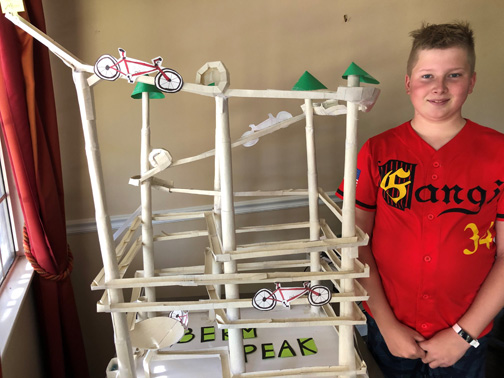
By Lori BODNAR, intern
“Scientists Can Do Virtually Anything!” was the theme for the 2021 virtual Science Fun Fair at Mountain Avenue Elementary School. The Science Fun Fair family night was held via a Zoom webinar the evening of Feb. 26. Over 100 students in grades transitional kindergarten through sixth submitted projects by recording videos of themselves explaining or demonstrating their science fair project. Videos were uploaded to Flipgrid for the students, classes, and families to view all the science project videos.
Seventeen sixth-grade students also participated in “The Great Paper Roller Coaster Engineering Challenge Build,” a challenge to create a marble run using the materials of cardstock paper, tape and a foam board base. The sixth-grade students videotaped and timed a marble rolling through their coaster creations, then uploaded their videos to Flipgrid. The paper roller coaster built by Joseph Christie, which he named “Berm Peak,” was the “longest ride” coaster keeping a marble traveling for over a minute down long track with loops, funnels and turns.
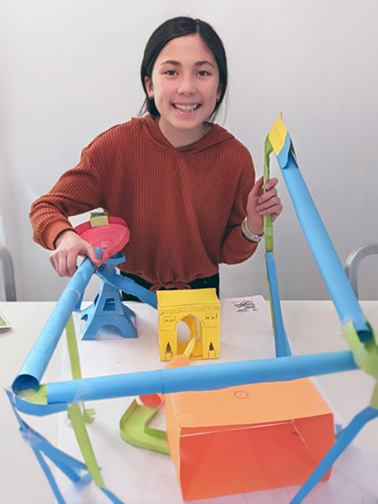
Sixth graders Audrey Chung, Avril Clementel, and Abbie Davidson tied for the best theme. Audrey’s coaster was titled, “A Trip Through Paris” and included the Eiffel Tower, Arc de Triomphe, and a baguette shop all made out of cardstock paper. Avril and Abbie’s paper roller coaster was named “Sun Snake Road.”
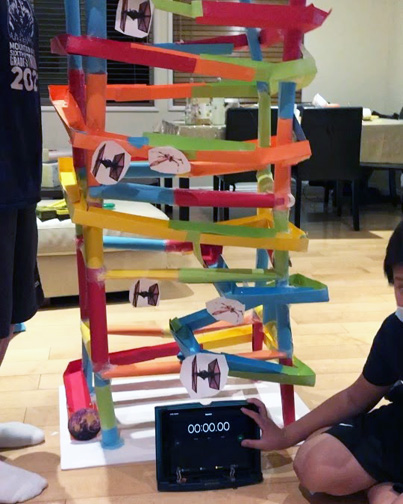
Recognition for best theme music was earned by Jung-Jae Yoon and Mark Shin for their Star Wars-themed coaster complete with accompanying music. All of the sixth graders who participated worked hard, learned engineering skills, and built some creative and ingenious coasters.
During Science Fair Week, Jaclyn Scott, the school principal, emailed daily a science-related question-of-the-day that pertained to virtual science, such as what scientists invented the internet, what does an “in silico” experiment mean, who uses virtual reality, what is the lightest metal on Earth used in cellphones and computers for virtual communication, and how long it takes JPL scientists or engineers to send a message to the Perseverance rover on Mars.
The Crescenta Valley High School Chemistry Club volunteered to assist at Mountain Avenue Science Fun Fair family night. During the virtual presentation, once all of the student’s projects were showcased, the CVHS Chemistry Club student panelists demonstrated chemistry experiments for the families that tuned in to view the Science Fun Fair webinar.
“I am so appreciative of the Mountain Avenue PTA for organizing and facilitating this traditional event,” said Scott. “It makes me so happy to see students extend their learning in the field of science. This event celebrates our high academic standards and brings our community together to celebrate achievements in science.”
This was the 12th annual Science Fun Fair, and the first one held virtually. The PTA co-chairs were molecular biologist/geneticist Dr. Jackie Bodnar and engineer Meena Arunachalam. The co-chairs wore matching T-shirts with the theme for the virtual science fair.
“Mountain Avenue students proved and assured organizers that the pandemic is not stopping their curiosity and interest towards science,” said Arunachalam. “There were some amazing projects and creative designs that popped out as students took advantage of the digital medium. The digital platform normalized some of the usual time constraints of being able to view all of the student projects.”
Added co-chair Bodnar, “I am pleased so many students participated in the virtual Science Fun Fair. We had a drive-thru pickup for poster boards and roller coaster build materials in January. Viewing all the ingenious, creative student science videos made for an exciting Science Fun Fair week. There were so many thoughtful projects ranging from a transitional kindergarten student’s very detailed handwritten scientific notebook researching succulent plant cutting root growth in soil versus water to the elaborate fifth-grader’s experiment who saved all of his lost teeth through the years, then soaked them in different liquids to determine which one dissolved teeth the fastest! I was very impressed with all of the student science projects across all grades.”
“The Science Fun Fair was so fun!” said fourth grade student Suzanna Bodnar. “I’ve done a science project every year since kindergarten, and I really want to do it again next year.”
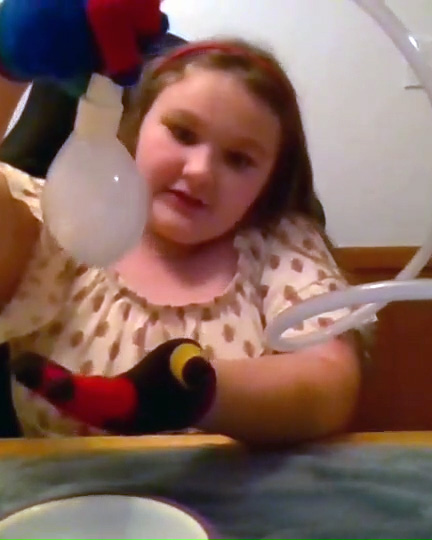
For her project, she demonstrated how to make dry ice bubbles using dry ice, water and bubble soap.
“Dry ice, or frozen carbon dioxide, is unusual in that when it warms up, it doesn’t melt to a liquid – it sublimes directly from a solid to a gas,” she said.
Fifth-grader Sammy Lee’s project was about studying bacteria on common surfaces.
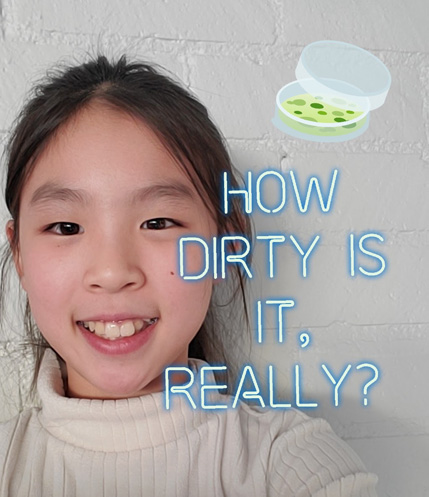
“I got to see how dirty surfaces are that we normally touch, and I learned cool things from other students’ projects,” said Sammy. “I came up with my project because of the coronavirus so we could find out how dirty common surfaces are, so we’d know if they need to be wiped a lot or not. It took about 10 days for the bacteria to grow fully, and then it took about 45 minutes to put together my Flipgrid video about my science research.
“Washing of hands does not take off all the germs because there was still quite a lot of bacteria that grew and on the hand sanitizer pump you would think it’d be dirty because it doesn’t get washed, but only a little bit of bacteria grew there. However, washing your hands is still better than dirty hands. Washing your hands and using hand sanitizer is the best.”
Fourth-grader Bianca Serratos also did her science project related to the pandemic, about how to deal with stress.
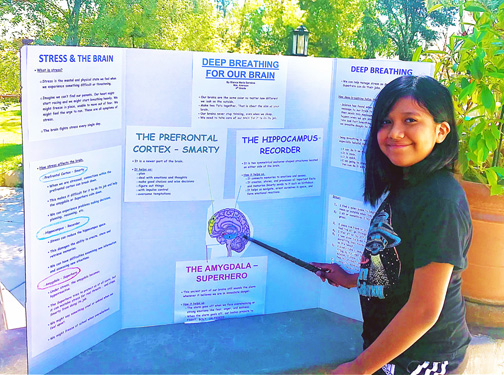
“I like to investigate what I see and feel,” said Bianca. “My favorite part about the Science Fun Fair was learning and researching my topic. I wanted to do a science project that can help us deal with some of the stress of COVID-19 quarantine. Like most students at Mountain Avenue Elementary, I am enrolled in distance learning. I miss seeing my friends, teachers and other staff. I miss being in the classroom and playing with my friends in school. Life is so different now and sometimes I feel stressed. I think other students may be feeling stressed, too. I like learning about the brain because it is so incredible. The brain is the center of the human nervous system, controlling our thoughts, movements, memories and decisions. I focused on deep breathing and the brain. I wanted to share what happens to our brains when we are stressed and what we can do to help our brains deal with stress.
“I don’t think that all students know deep breathing can help manage stress. It is easy to do and you can do it on your own. It has helped me and I think it can help other students. It’s important to share what helps us during quarantine. It took me about three weeks to research and work on my science project. This is the first time I have participated in the science fair. I did not realize how much fun it could be. I encourage all students to be part of it.”
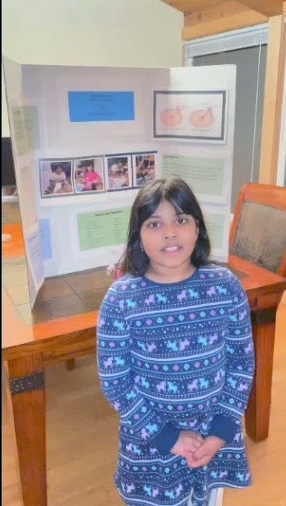
“I like merry-go-rounds and I wanted to know why I get dizzy riding them,” said second-grader Maya Manchikatla. “It took me two weeks to work on the project. I was preparing for this project since December, ever since I got my science experiment book for Christmas.”
Sisters Alisha and Alina Singh completed a science project together about non-Newtonian fluids, such as oobleck.
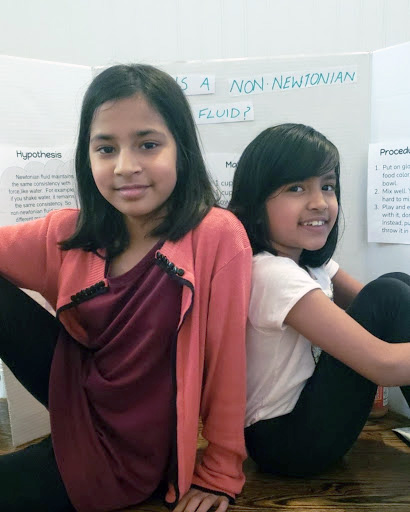
“We like that we get to learn not just about the project we are doing, but also about topics presented by other students,” said Alisha.
Alina added, “We got the idea for our science project from the TV show called ‘Emily’s Wonder Lab.’ We found it interesting because we did not realize force can have an impact on the consistency of liquids and wanted to experiment and learn more.”
“It took about two weeks experimenting with corn starch for making oobleck, creating the contents for our science fair poster board, and getting the video recording ready to upload,” said Alisha. “This is my fourth year and Alina’s second year participating in the science fair. This year, we still put in the same effort as before, but everything needed to be submitted and viewed virtually.”
Another project was born from the love of bubble gum.
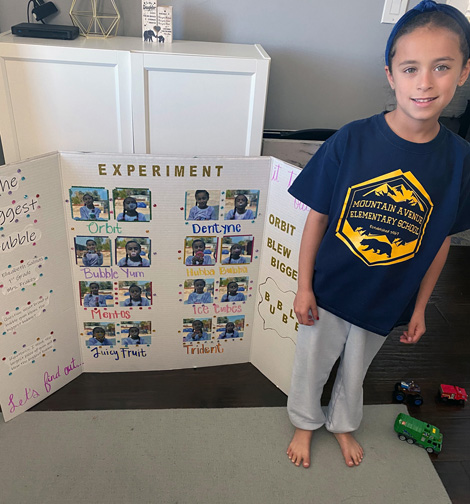
“I chose my science project, ‘The Biggest Bubble-Gum Bubble’, because I love chewing bubble gum!” said first-grader Elizabeth Salinas.
Her brother, kindergartener Alejandro Salinas, also participated in the science fair.
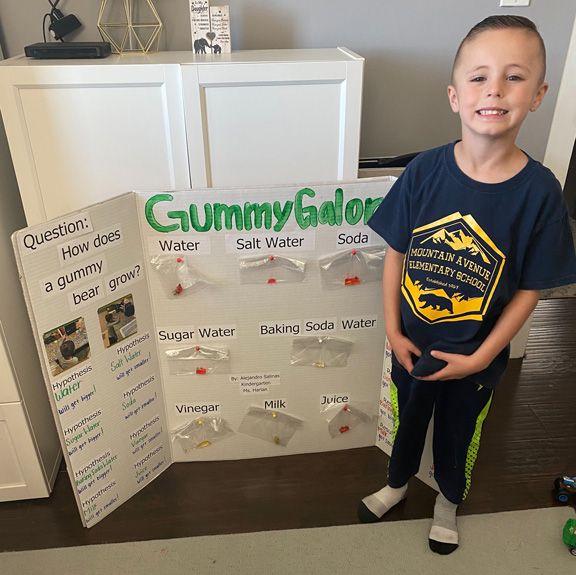
“It was really fun to choose all the ingredients for my project, ‘Gummy Galore!’ I like that I was right about my prediction, or hypothesis,” he said. “The gummy bear project looked really fun and I wanted to see which one would be the biggest when I soaked gummy bears in different liquids. I really liked doing experiments!”
Alejandro and his sister Elizabeth spent about a week each on their science projects and it was their first time participating in the science fair.
“I enjoyed doing a science fair project because I love making animated movies,” explained fourth-grader Zachary Yang whose project focused on animation. “I liked that I was able to make an animated movie ‘What is Animation.’ It took me around six days to do the project because I am used to doing animation without voice-overs, so I had to figure out how to do them.”
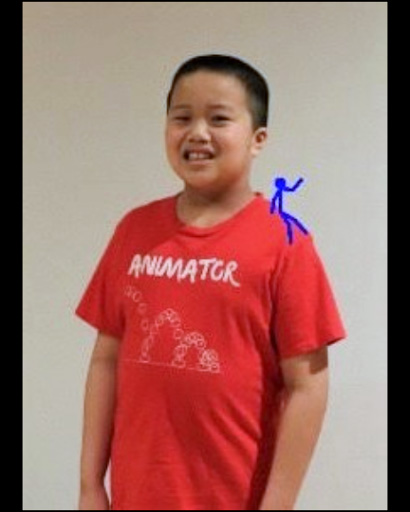
Zachary added that the science of animation and how the frames per second or animation speed makes it look like the animated pictures are moving.
Learning while creating his project and also viewing the projects of others were favorite things for third grade student Vivek Arunachalam. Vivek made a homemade lava lamp from oil, water, food coloring and AlkaSeltzer fizzing tablets that produce effervescence from a sodium bicarbonate and citric acid chemical reaction.
“I searched the Internet for science project ideas and lava lamps interested me because it was cool,” Vivek said. “It took me about two weeks to finish. I’m glad there was still a science fair this year with the virtual format, but I like the in-person science fair more with the robotics and hands-on activities.”
Vivek’s brother, fifth-grader Pranav, also completed a science fair project. He studied the best pot to use for cooking to preserve food nutrients. His mom helped suggest the idea, which he liked because it demonstrated how simple choices can affect our nutrition. His project took a month to compare cooking with different types of metal pots and the resulting effects on the nutrients of cooked food.
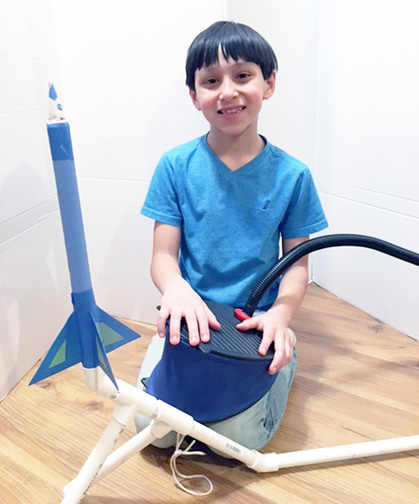
“I enjoyed hearing about all of the science projects, including the sixth-grade roller coasters,” said Pranav. “I liked the Crescenta Valley High School Chemistry Club activities and the Diet Coke/Mentos geyser was very cool. This year’s virtual fair didn’t have all the in-person experiences due to being online, but it was still fun. I hope next year’s fair can happen in-person!”
After the student names, project names, and science fair project pictures were shown for the students who participated during Science Fun Fair family night, then the Chemistry Club demonstrated fun experiments for the virtual fair to keep with the tradition of incorporating “hands-on,” engaging science activities.
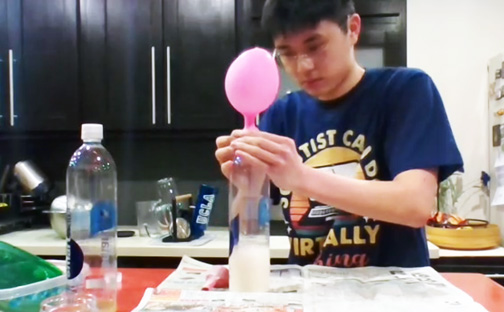
Chemistry Club co-president Seon-Jae Yoon had a ping pong ball demonstration in which she blew air on the ping pong ball to move the ball from one cup to the other. Co-president Matthew Jang showed the audience how to make different kinds of slime and explained the chemical reaction behind the gooey process. Chemistry Club member Nara Sirkanian made an oobleck demonstration using cornstarch and water. Hyun-Tae Yang showed an experiment with vinegar and baking soda in a plastic bottle to blow up a balloon through the expanding carbon dioxide gas created from the chemical reaction. The high school Chemistry Club advisor is Julie Patton. (For more information about the CVHS Chemistry Club, see the CV Weekly Feb. 11 issue).
Following the CV Chemistry Club demonstrations, the children of the PTA co-chairs – Pranav Arunachalam, Vivek Arunachalam and Suzy Bodnar – demonstrated how to make a lava lamp from oil, water, food coloring and AlkaSeltzer fizzing bicarbonate tablets. The Mountain Avenue students enjoyed watching both the chemistry club and student demonstrations.
The CVHS Falcon Robotics Team 589 usually brings one of its robots to the Mountain Avenue Science Fun Fair, much to the delight of the elementary school students who take turns maneuvering various robots every year. This year, due to the virtual format, Team 589 sent a “build video,” which used stop-motion technology to show the students how they design, create, build, and test their robots using video and still photo footage from 2019. The CVHS senior student leadership team that helped create the robotic build video this year are Eric Limonadi, Jaya Hamkins, Kimberley Miller, and Adarsh Chilkunda. The Robotics Team 589 mentors are CVHS teacher Gregory Neat and JPL scientist Lyn Repath-Martos. When the Mountain Avenue elementary students watched the robotic build video, they were reminded about the robotic rover Perseverance that recently landed on Mars and how JPL scientists communicate virtually with the rover.
Ending the evening was fourth grade student Suzy Bodnar dropping Mentos candy into a 2-liter bottle of Diet Coke to create the traditional 20-foot high soda geyser, a physical reaction marvel that expels all at once the soda carbonation.





